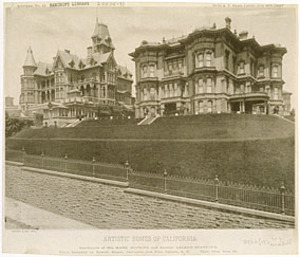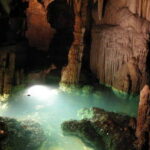Nob Hill has a fascinating tale to tell of rivalry, greed, fame, earthquake and fire, and disastrous ruin. Its reputation goes back to the pre-Gold Rush days when it was known as Clay Hill. Muddy and unpaved, the steep hill overlooked the shanty town of Yerba Buena with fewer than 500 souls. It was anything but posh. Today, Nob Hill is home to several of the city’s finest hotels, lounges, restaurants, a private club, condos, with steep hills used by movie-makers for high-speed chase scenes.
Introducing Nob Hill
San Francisco City Guides offers a free 90-minute walking tour every Sunday, Wednesday, and Thursday afternoon at 2 p.m. throughout the year. This tour takes in wonderful stories of the Big Four railroad and silver barons who built palaces upon this hill. Walkers see the only brownstone in San Francisco, which incidentally survived the earthquake with extensive damage to the interiors. Guides escort groups through impressive Grace Cathedral, the third largest Episcopal cathedral in the United States with dozens of stained glass windows, three organs, and a replica of Florence’s Gates of Paradise by Ghiberti.
The cable car
Our guide, Manuel, explained that in 1873, the new cable car made the steep incline of unpaved Clay Hill accessible, kicking off the explosion of a lavish building frenzy by the ultra wealthy who coveted the sparsely populated hill with its magnificent bay views.
The Big Four
These gentlemen were awarded the contract to build the western end of the railroad which would connect the nation coast-to-coast in 1869. They were formerly small merchants: Mark Hopkins, Leland Stanford, Charles Crocker, and Collis Huntington. The Big Four became fantastically wealthy, and with an assist from their spouses, proceeded to outbuild one another for spite.
Mansions of Nob Hill
The ostentatious, turreted Hopkins gingerbread mansion had 70 rooms just for himself and his wife, Mary, who was also his first cousin. Stanford, future governor and university founder, constructed an enormous mansion filled with costly art where the Stanford Court Hotel stands today. The Crockers built where Grace Cathedral now stands, a mansion containing 35 Degas masterpieces, among other fine art treasures. Crocker had the biggest challenge of all, a neighbor who refused to sell his small abode which stood in Crocker’s expansive way. Your San Francisco City Guide explains what happened next; it’s the story of a fence, a coffin, and the worst neighbors ever, known as “Crocker’s Spite.” At the center of the neighborhood is the former mansion of tycoon James Flood, now the headquarters of the exclusive men-only 750 member Pacific Union Club.
Sixty seconds of terror
At 5:12 a.m. on April 18, 1906, everything in the San Francisco Bay Area changed in the minute which followed. More than 50 fires broke out due to ruptured gas lines, even before the rumbling stopped. Within 24 hours, the multi-million dollar mansions of Nob Hill became gutted ruins or had crumbled to the ground. With 80 percent of the city destroyed, San Francisco began the massive rebuilding, creating the posh Nob Hill that we appreciate to this day.




